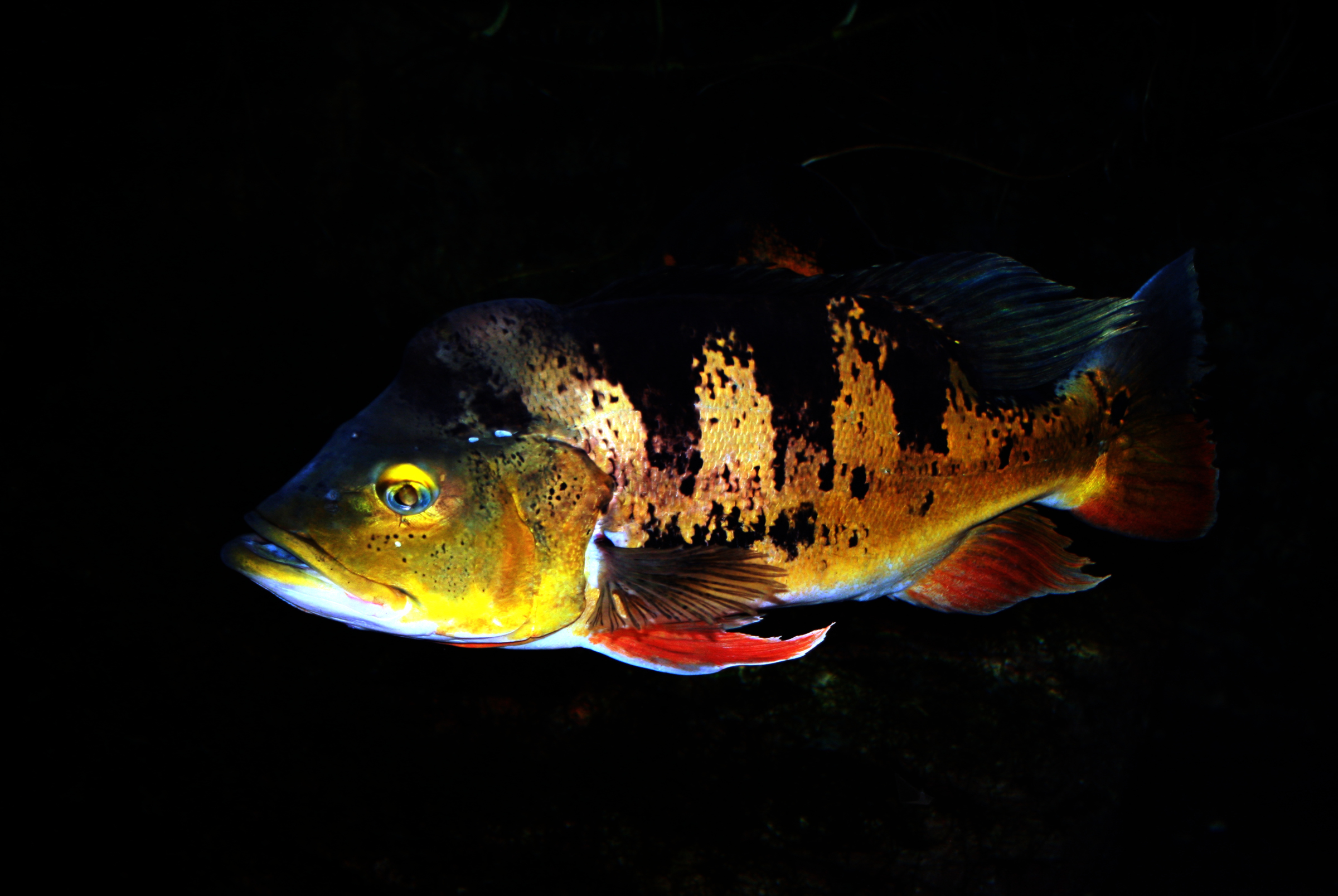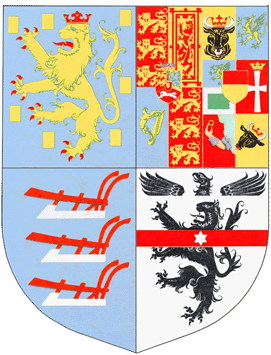|
Peacock Bass
Peacock bass or Brazilian tucunaré are large freshwater cichlids of the genus ''Cichla''. These are diurnal predatory fishes native to the Amazon and Orinoco basins, as well as rivers of the Guianas, in tropical South America. They are sometimes referred to in English by their Brazilian name ''tucunaré'' or their Spanish name ''pavon''. Despite the common name and their superficial similarity, they are not closely related to other fish known as bass, such as the North American largemouth bass (''Micropterus salmoides''). Peacock bass are important food fish and also considered valuable game fish. This has resulted in their accidental (escapees from fish farms) or deliberate (release by fishers) introduction to regions outside their native range, both elsewhere in South America, and in warm parts of North America and Asia. Singles have been caught elsewhere, including Australia, but do not appear to have become established there. Where established as an introduced species, t ... [...More Info...] [...Related Items...] OR: [Wikipedia] [Google] [Baidu] |
Butterfly Peacock Bass
''Cichla ocellaris'', sometimes known as the butterfly peacock bass ("peacock bass" is also used for some of its relatives), is a very large species of cichlid from South America, and a prized game fish. It reaches in length. It is native to the Marowijne and Essequibo drainages in the Guianas, and the Branco River in Brazil. It has also been introduced to regions outside its natural range (e.g., Florida, Hawaii, and Puerto Rico), but some uncertainty exists over the exact identity, and at least some of the introductions may involve another ''Cichla'' species or hybrids.Nico, L. (2011). Cichla ocellaris.' USGS Nonindigenous Aquatic Species Database, Gainesville, FL. It is frequently confused with '' C. monoculus''. Studies conclude that the introduction of ''Cichla ocellaris'' does not negatively impact fish communities in Florida, making it an effective fisheries management tool.Shafland, P. L. (1999). The Introduced Butterfly Peacock (Cichla ocellaris) in Florida. I. Fish ... [...More Info...] [...Related Items...] OR: [Wikipedia] [Google] [Baidu] |
Largemouth Bass
The largemouth bass (''Micropterus salmoides'') is a carnivorous freshwater gamefish in the Centrarchidae ( sunfish) family, a species of black bass native to the eastern and central United States, southeastern Canada and northern Mexico, but widely introduced elsewhere. It is known by a variety of regional names, such as the widemouth bass, bigmouth bass, black bass, bucketmouth, largies, Potter's fish, Florida bass, Florida largemouth, green bass, bucketmouth bass, Green trout, gilsdorf bass, Oswego bass, LMB, and southern largemouth and northern largemouth. The largemouth bass is the state fish of Georgia and Mississippi, and the state freshwater fish of Florida and Alabama. Taxonomy The largemouth bass was first formally described as ''Labrus salmoides'' in 1802 by the French naturalist Bernard Germain de Lacépède with the type locality given as the Carolinas. Lacépède based his description on an illustration of a specimen collected by Louis Bosc near Charleston, S ... [...More Info...] [...Related Items...] OR: [Wikipedia] [Google] [Baidu] |
Antonio Machado-Allison
Antonio is a masculine given name of Etruscan origin deriving from the root name Antonius. It is a common name among Romance language-speaking populations as well as the Balkans and Lusophone Africa. It has been among the top 400 most popular male baby names in the United States since the late 19th century and has been among the top 200 since the mid 20th century. In the English language it is translated as Anthony, and has some female derivatives: Antonia, Antónia, Antonieta, Antonietta, and Antonella'. It also has some male derivatives, such as Anthonio, Antón, Antò, Antonis, Antoñito, Antonino, Antonello, Tonio, Tono, Toño, Toñín, Tonino, Nantonio, Ninni, Totò, Tó, Tonini, Tony, Toni, Toninho, Toñito, and Tõnis. The Portuguese equivalent is António (Portuguese orthography) or Antônio (Brazilian Portuguese). In old Portuguese the form Antão was also used, not just to differentiate between older and younger but also between more and less important. In Galician t ... [...More Info...] [...Related Items...] OR: [Wikipedia] [Google] [Baidu] |
Cichla Intermedia
''Cichla intermedia'', the royal peacock bass, is a large species of cichlid found in the Orinoco River basin in Venezuela and Colombia. at Description ''C. intermedia'' reaches up to in and in weight. It is easily identified from other species of , as it is the only that present a series of 8 to 9 spots running through their |
Cichla Cataractae
Peacock bass or Brazilian tucunaré are large freshwater cichlids of the genus ''Cichla''. These are diurnal predatory fishes native to the Amazon and Orinoco basins, as well as rivers of the Guianas, in tropical South America. They are sometimes referred to in English by their Brazilian name ''tucunaré'' or their Spanish name ''pavon''. Despite the common name and their superficial similarity, they are not closely related to other fish known as bass, such as the North American largemouth bass (''Micropterus salmoides''). Peacock bass are important food fish and also considered valuable game fish. This has resulted in their accidental (escapees from fish farms) or deliberate (release by fishers) introduction to regions outside their native range, both elsewhere in South America, and in warm parts of North America and Asia. Singles have been caught elsewhere, including Australia, but do not appear to have become established there. Where established as an introduced speci ... [...More Info...] [...Related Items...] OR: [Wikipedia] [Google] [Baidu] |
FishBase
FishBase is a global species database of fish species (specifically finfish). It is the largest and most extensively accessed online database on adult finfish on the web.Marine Fellow: Rainer Froese ''Pew Environment Group''. Over time it has "evolved into a dynamic and versatile ecological tool" that is widely cited in scholarly publications. FishBase provides comprehensive species data, including information on , geographical distribution, and |
Taxonomy (biology)
In biology, taxonomy () is the scientific study of naming, defining ( circumscribing) and classifying groups of biological organisms based on shared characteristics. Organisms are grouped into taxa (singular: taxon) and these groups are given a taxonomic rank; groups of a given rank can be aggregated to form a more inclusive group of higher rank, thus creating a taxonomic hierarchy. The principal ranks in modern use are domain, kingdom, phylum (''division'' is sometimes used in botany in place of ''phylum''), class, order, family, genus, and species. The Swedish botanist Carl Linnaeus is regarded as the founder of the current system of taxonomy, as he developed a ranked system known as Linnaean taxonomy for categorizing organisms and binomial nomenclature for naming organisms. With advances in the theory, data and analytical technology of biological systematics, the Linnaean system has transformed into a system of modern biological classification intended to reflect the evolu ... [...More Info...] [...Related Items...] OR: [Wikipedia] [Google] [Baidu] |
Giant Cichlid
The giant cichlid (''Boulengerochromis microlepis''), also known as the emperor cichlid, is a species of fish in the family Cichlidae, endemic to Lake Tanganyika in Africa.''Boulengerochromis microlepis'' FishBase (2006) Eds. Froese, R. and D. Pauly. fishbase.org version (07/2014).SeriouslyFish Boulengerochromis microlepis. Retrieved 6 April 2017. It is the only member of its ''Boulengerochromis'' an ... [...More Info...] [...Related Items...] OR: [Wikipedia] [Google] [Baidu] |
Rutgers University
Rutgers University (; RU), officially Rutgers, The State University of New Jersey, is a Public university, public land-grant research university consisting of four campuses in New Jersey. Chartered in 1766, Rutgers was originally called Queen's College, and was affiliated with the Reformed Church in America, Dutch Reformed Church. It is the eighth-oldest college in the United States, the second-oldest in New Jersey (after Princeton University), and one of the nine U.S. colonial colleges that were chartered before the American Revolution.Stoeckel, Althea"Presidents, professors, and politics: the colonial colleges and the American revolution", ''Conspectus of History'' (1976) 1(3):45–56. In 1825, Queen's College was renamed Rutgers College in honor of Colonel Henry Rutgers, whose substantial gift to the school had stabilized its finances during a period of uncertainty. For most of its existence, Rutgers was a Private university, private liberal arts college but it has evolved int ... [...More Info...] [...Related Items...] OR: [Wikipedia] [Google] [Baidu] |
Speckled Peacock Bass
''Cichla temensis'', the speckled pavon, speckled peacock bass, painted pavon, or three-barred peacock bass, is a very large South American cichlid, and a prized food and game fish. Reaching up to in length and in weight, it is the largest cichlid of the Americas, and perhaps the largest extant cichlid in the world, with only Tanganyika's giant cichlid, ''Boulengerochromis microlepis'', reaching similar proportions. Range ''C. temensis'' is native to the Orinoco and Rio Negro basins, as well as several smaller rivers in the central Amazon ( Uatumã, Preto da Eva, Puraquequara, and Tefé), in Brazil, Venezuela and Guyana. In its native range, it is essentially restricted to blackwater rivers and their tributaries. Introduction attempts have been made outside its native range, but it has not managed to become established in Florida or Texas. In contrast, it has flourished in tropical Singapore and Malaysia. Appearance ''C. temensis'' resembles other peacock bass species, bu ... [...More Info...] [...Related Items...] OR: [Wikipedia] [Google] [Baidu] |
Invasive Species
An invasive species otherwise known as an alien is an introduced organism that becomes overpopulated and harms its new environment. Although most introduced species are neutral or beneficial with respect to other species, invasive species adversely affect habitats and bioregions, causing ecological, environmental, and/or economic damage. The term can also be used for native species that become harmful to their native environment after human alterations to its food webfor example the purple sea urchin (''Strongylocentrotus purpuratus'') which has decimated kelp forests along the northern California coast due to overharvesting of its natural predator, the California sea otter (''Enhydra lutris''). Since the 20th century, invasive species have become a serious economic, social, and environmental threat. Invasion of long-established ecosystems by organisms is a natural phenomenon, but human-facilitated introductions have greatly increased the rate, scale, and geographic range of ... [...More Info...] [...Related Items...] OR: [Wikipedia] [Google] [Baidu] |
Introduced Species
An introduced species, alien species, exotic species, adventive species, immigrant species, foreign species, non-indigenous species, or non-native species is a species living outside its native distributional range, but which has arrived there by human activity, directly or indirectly, and either deliberately or accidentally. Non-native species can have various effects on the local ecosystem. Introduced species that become established and spread beyond the place of introduction are considered naturalized. The process of human-caused introduction is distinguished from biological colonization, in which species spread to new areas through "natural" (non-human) means such as storms and rafting. The Latin expression neobiota captures the characteristic that these species are ''new'' biota to their environment in terms of established biological network (e.g. food web) relationships. Neobiota can further be divided into neozoa (also: neozoons, sing. neozoon, i.e. animals) and neophyt ... [...More Info...] [...Related Items...] OR: [Wikipedia] [Google] [Baidu] |





